If you want to understand the schism that dominates the political and social landscape in this famously liberal city, a walk down Southeast Rhine Street might be a good place to start.
Flora Gonzalez, who lives on the north side of the street, is distressed about conditions in the historically blue-collar neighborhood.
The 40-year-old package handler for FedEx said that people have openly dealt drugs and urinated on the sidewalk outside her family’s duplex. They‘ve dumped feces and used syringes in her manicured yard, played booming music at 3 a.m. and stripped stolen cars for parts. Shots have been fired behind her children’s bedroom.
“We feel abandoned,” Gonzalez said. “We pay our taxes and the police are not watching over our security.”
But Juniper Simonis, who rents a home across the street, said she opposed calls for police clampdowns.
The 38-year-old environmental biologist and data scientist, whose frontyard features a handmade “DISARM, DEFUND, DISMANTLE POLICE” sign, said Portland officials continued to fail the homeless by underfunding services and “sweeping” camps with callous disregard for people’s dignity and property.
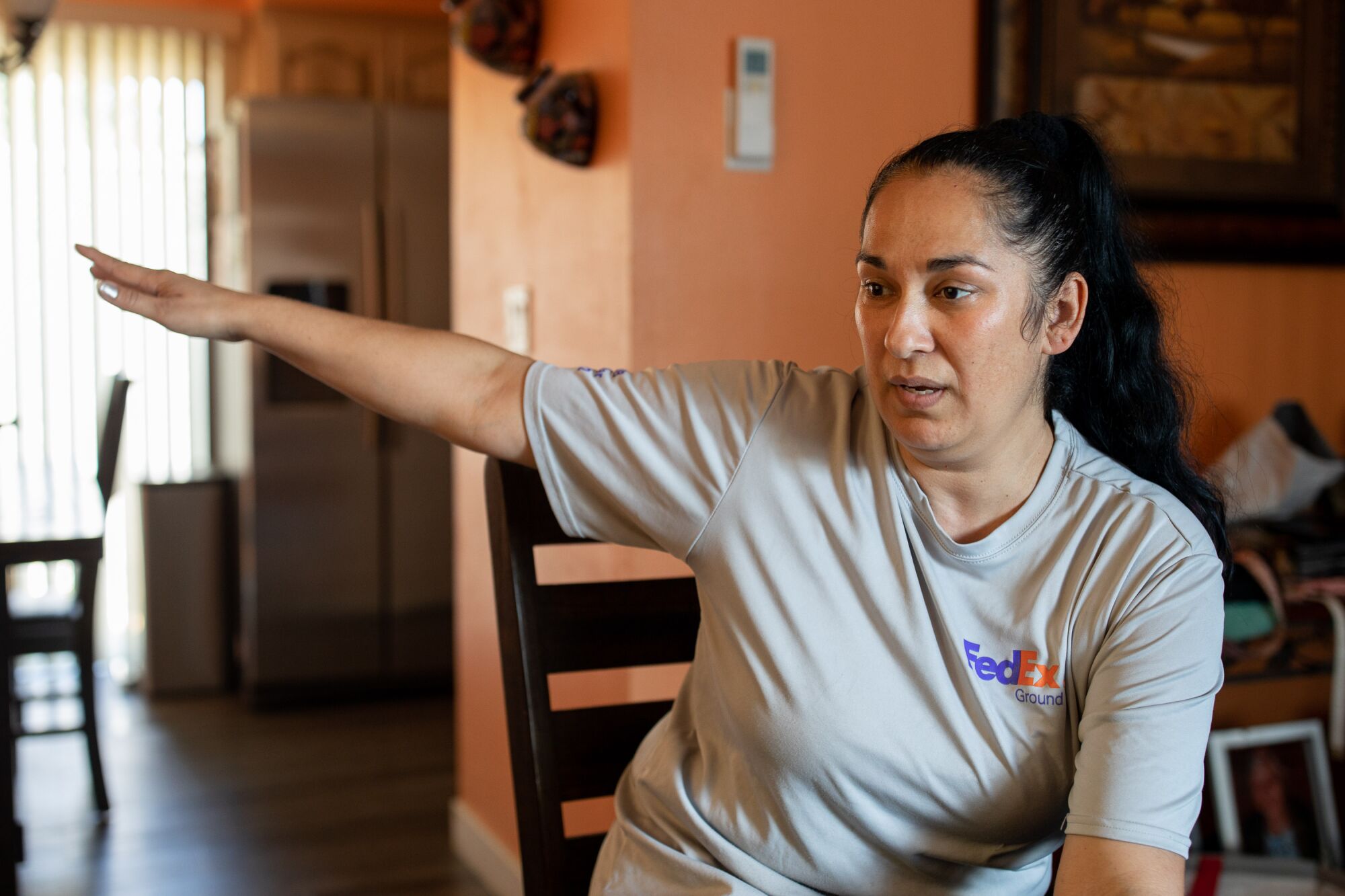
Flora Gonzalez worries about the rising crime rate and an increase in homelessness in Portland.
(John Rudoff/For The Times)
An activist who marched downtown in 2020, Simonis said the problem is not that Portland is too liberal, but that it is not liberal enough. “There’s a lack of resources, and I think of being liberal in terms of spending money to provide support services,” Simonis said. “Trying to regulate homelessness out of a city, I don’t view that as liberal at all.”
Long hailed as a model of conscientious urban planning and civic engagement, Portland is facing a crisis of confidence. Nearly three years after pandemic lockdowns emptied out the city’s core and protests against police brutality turned a few downtown blocks into a battleground, this city of about 641,000 is dealing with skyrocketing numbers of homeless people, soaring crime and strikingly high levels of public dissatisfaction with what the city is doing about it.
Over the last three years, the number of unhoused people in the metro area has jumped from about 4,000 to at least 6,600. Shootings in the city have tripled. Homicides climbed from 36 in 2019 to 97 last year — a record. Lower-level crimes have spiked too: More than 11,000 vehicles were stolen in 2022, up from 6,500 in 2019.
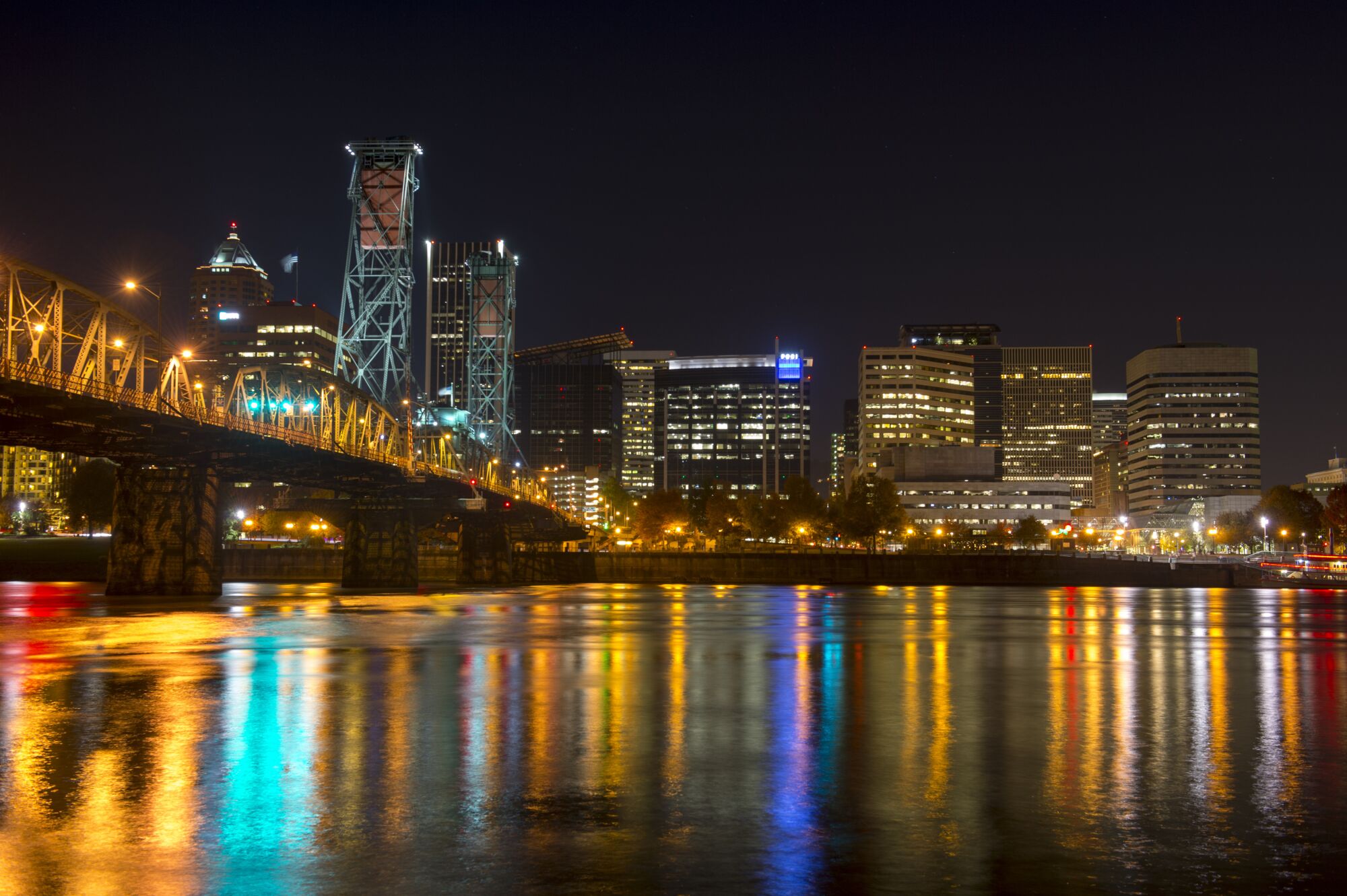
The Hawthorne Bridge crosses the Willamette River in Portland, Ore., where polls last year showed only 11% of voters thought the city was heading in the right direction.
(Wolfgang Kaehler/LightRocket via Getty Images)
“You don’t have to watch Fox News to look around Portland and say, ‘This is not cool,’” said City Commissioner Mingus Mapps, a Democrat and former political science professor at Brandeis University.
Fatal drug overdoses nearly doubled between 2019 and 2021 across Multnomah County. The fentanyl epidemic combined with the housing crisis, Mapps said, made for a “scary” situation.
Conservatives have long branded this city Exhibit A for how liberals and so-called “woke” policies have run amok. While many Portlanders roll their eyes at such tropes, polls conducted last year showed only 11% of voters thought Portland was heading in the right direction — a steep drop from 36% in 2020 and 76% in 2000.
A backlash is underway. In November, voters passed a measure to overhaul city government and ousted the city’s most outspoken left-wing commissioner, who led a 2020 charge to cut police funds. But they are struggling to agree on how it can return to being the place many once viewed as a liberal utopia.

Tents fill a vacant parking lot in Portland in December 2020.
(Craig Mitchelldyer / Associated Press)
For nearly half a century, Portland was lauded as a model American metropolis, thanks to public and private initiatives, its waterfront and its proximity to mountains and coast.
In the 1970s, as the western suburbs grew and downtown’s older buildings were razed for parking lots, Portland began to take key steps that set it apart from most other U.S. cities. To ward off rising crime, neighborhood groups and activists worked with city leaders to revitalize downtown by expanding public transit, preserving historic buildings and fostering new public space and retail stores.
At the same time, Oregon’s governor pushed to create urban growth boundaries to preserve the state’s natural beauty and encourage downtown density, and to demolish the city’s riverfront highway to reclaim it as a waterfront park.
Portland began to reach the top of list after list of livable American cities, winning accolades for its thoughtful planning. In 1992, journalist and urban critic Philip Langdon marveled at how “this courteous, well-kept city of 453,000, and especially its downtown, has become a paragon of healthy urban development.”
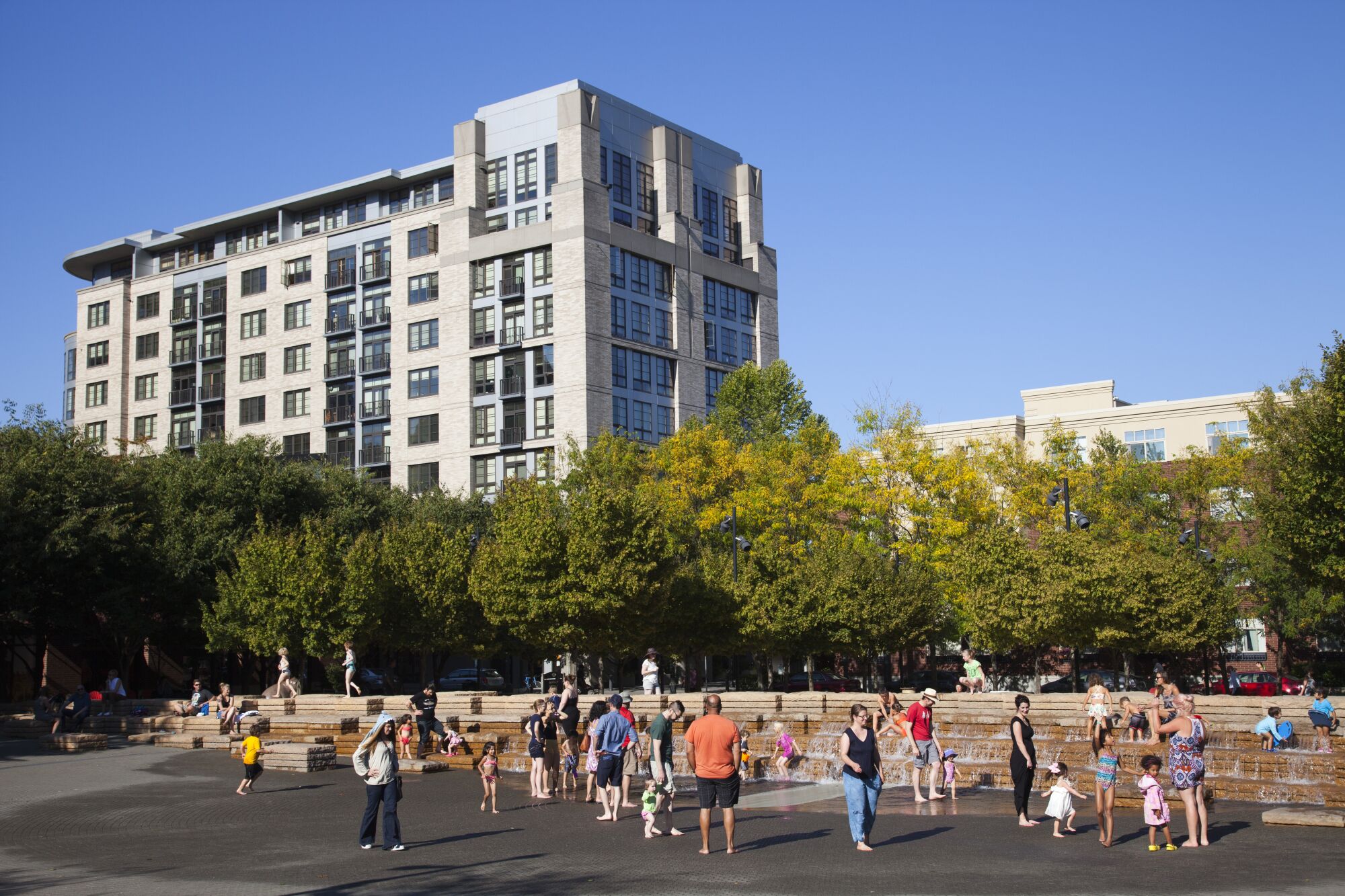
Portlanders enjoy a sunny day at Jamison Square.
(Getty Images)
By the late 1990s, Portland was starting to become a top destination for college-educated 20- and 30-somethings lured by its affordability, DIY mentality and the riot grrrl and indie rock scene. A decade later, the TV show “Portlandia” cast the city as the place “where young people go to retire,” a twee sanctum where privileged residents cultivated esoteric identities, experimented with pursuits like craft beer and kombucha, and waged grand battles over tiny differences.
But the model American metropolis was evolving — and the combination of population growth, a housing shortage and the strict urban growth boundary started pricing out poor residents. By 2015, rents were risingmore sharply than in almost any other U.S. city. Homelessness began to rise.
In 2018, voters in this predominantly white city elected their first Black female city commissioner: Jo Ann Hardesty, a left-wing activist who had campaigned for police reform and reducing city sweeps of homeless encampments.
It was time, she said in her victory speech, “for a different kind of Portland.”
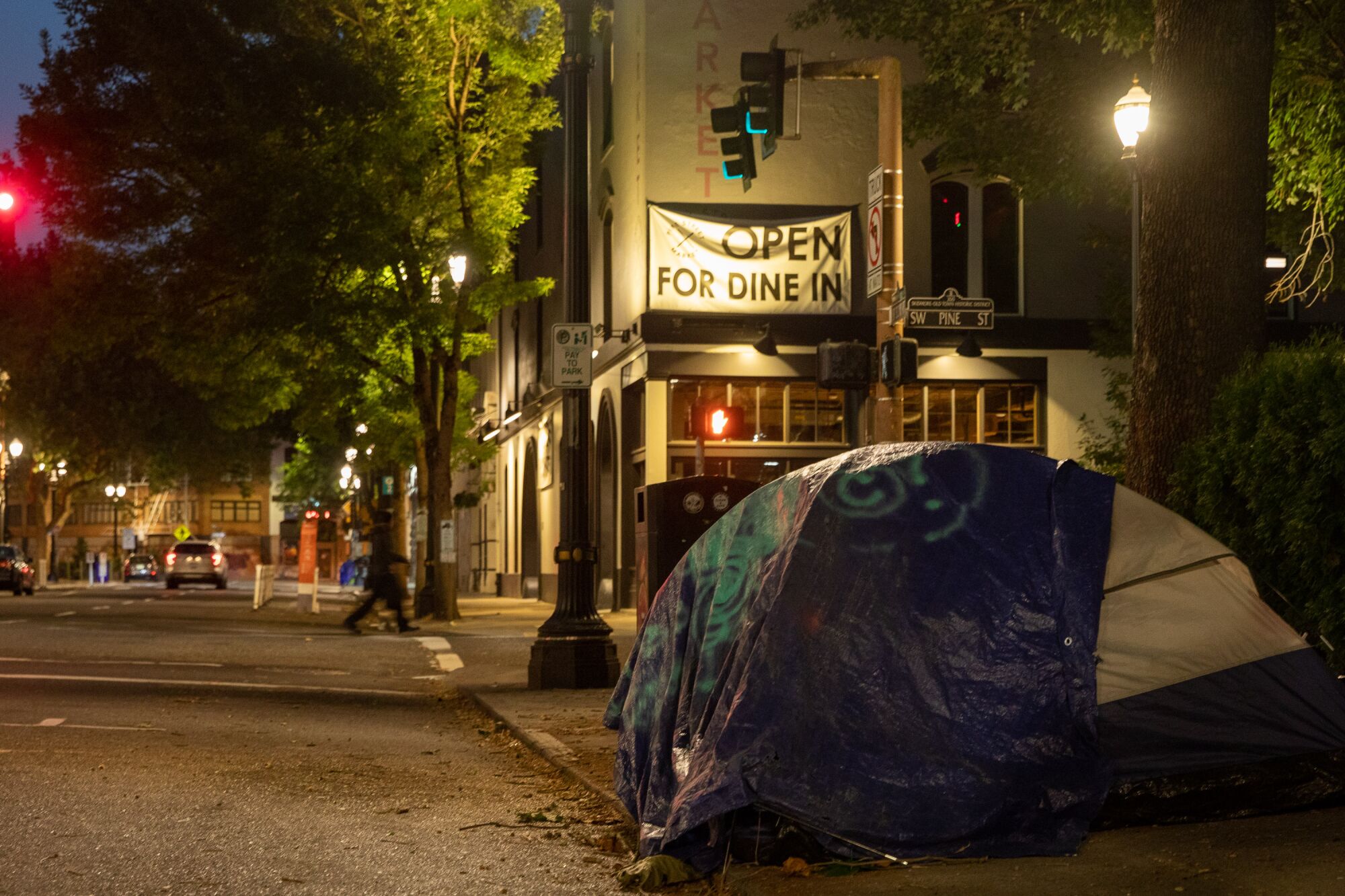
A tent on a Portland sidewalk in September 2022.
(John Rudoff / For The Times)
The shutdowns of 2020 ravaged downtown, hollowing out core sections of the city as businesses closed and offices shifted to remote work. Then for months after the police killing of George Floyd in Minneapolis, hard-core protesters converged outside the federal courthouse night after night — setting fires and hurling fireworks at authorities — prompting President Trump to send in federal troops.
Mayor Ted Wheeler sided with protesters, at one point standing alongside black-clad demonstrators as they were tear-gassed. But many activists booed Wheeler, who would not commit to defunding the police. Six months later, he was accosted and reportedly punched by a social justice activist at a cafe.
The vibe of the city was shifting. A mayor who began his first day in office biking to work was now accompanied by bodyguards.
In the summer of 2020, Portland’s city commissioners voted to cut the police budget by $15 million — short of the $50 million some demanded — and disband its Gun Violence Reduction Team, which critics had long accused of disproportionately targeting young Black men. It also invested in Portland Street Response program, which dispatches unarmed paramedics and health workers to help people experiencing mental health and substance abuse crises.
The next year, as the city contended with a record number of shootings and homicides, commissioners turned around and voted to increase the police budget. They also set up a new gun violence team with more oversight.
But violence continued to escalate.
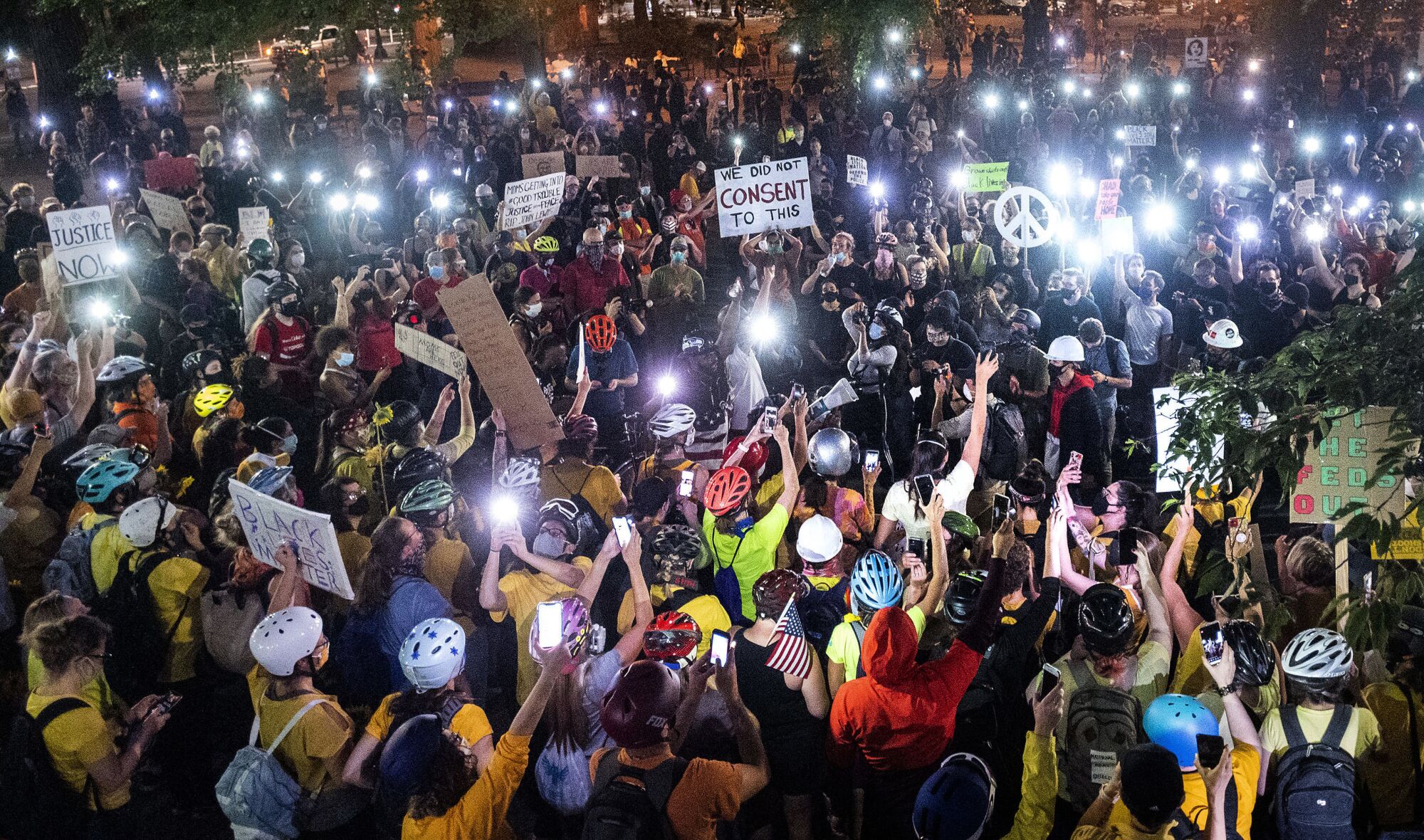
Hundreds of Black Lives Matter protesters rally near Portland’s federal courthouse on July 21, 2020.
(Noah Berger / Associated Press)
Thousands moved away. After decades of growth, the city’s population dropped in 2021 by 1.7%.
The grim headlines did not let up. Last June, an 82-year-old professor died after he was knocked to the ground and beaten in an unprovoked attack at a downtown bus stop. In August, nine people were injured and two people killed by gunfire in one weekend as police struggled to respond to a rash of street takeovers.
One incident in particular, involving the Portland Freedom Fund, a self-described “abolitionist organization” that focuses on helping low-income, Black and minority defendants post bail, tested Portlanders’ commitment to the Black Lives Matter movement. In August, the organization posted bail for Mohamed Osman Adan, who had repeatedly attacked and threatened Rachael Angel Abraham, the mother of his children.
A week later, Portland police arrested Adan after finding Abraham, a 36-year-old Black woman, in her home strangled to death and slashed in the face with a kitchen knife.
John Toran, 47, the Black owner of a construction company who was born and raised in Portland, said he understood the bail fund was trying to counter malicious prosecution and inequality in the criminal justice system. But, he said, people felt less safe and the city had a duty to respond.
“‘Progressive’ means something different now than when it did when I was growing up,” the longtime Democrat said. “Now, when I think of progressive, I think of extremism.”
Portland still has many of its charms: towering firs and giant sequoias, efficient light rail and bike lanes, microbreweries and craft markets, and views of snow-capped Mt. Hood.
But downtown, some buildings remain boarded up. The unhoused roll shopping carts of stuffed trash bags down empty streets as construction crews erect a glossy 35-story Ritz-Carlton, the city’s first five-star hotel. A recent study showed Portland ranks about average compared with 40 other cities when it comes to homicide, assault and robbery rates. But the surge in crime has resulted in an identity crisis.
“It very much begins to erode that whole progressive ethos that the city has had,” said historian Chet Orloff, adjunct professor of urban studies and planning at Portland State University.
Conservatives have blamed Portland’s troubles on left-wing policies: police cuts that led to a drop in morale and staffing shortages; harm reduction programs that offer homeless addicts shelter and other services without insisting they pass background checks or be sober; and the state’s Measure 110, which decriminalized small amounts of hard drugs.
Wheeler said cities across the nation were seeing spikes in homelessness and argued that the culprit was a failure of state and federal safety nets.
Since he became mayor in 2017, annual city spending for homeless housing and services has climbed from about $27 million to a record $94 million. The city’s first Safe Rest Village, a temporary outdoor shelter of 30 tiny homes designed to help people transition into permanent housing, opened last summer. Officials plan to eventually have six across the city.
Still, Wheeler called the homelessness crisis a “humanitarian catastrophe” in October and proposed a sharp change in strategy — banning unsanctioned camping on city streets by 2024 and setting up large, designated campsites where unsheltered people can access services, including addiction and mental health treatment.
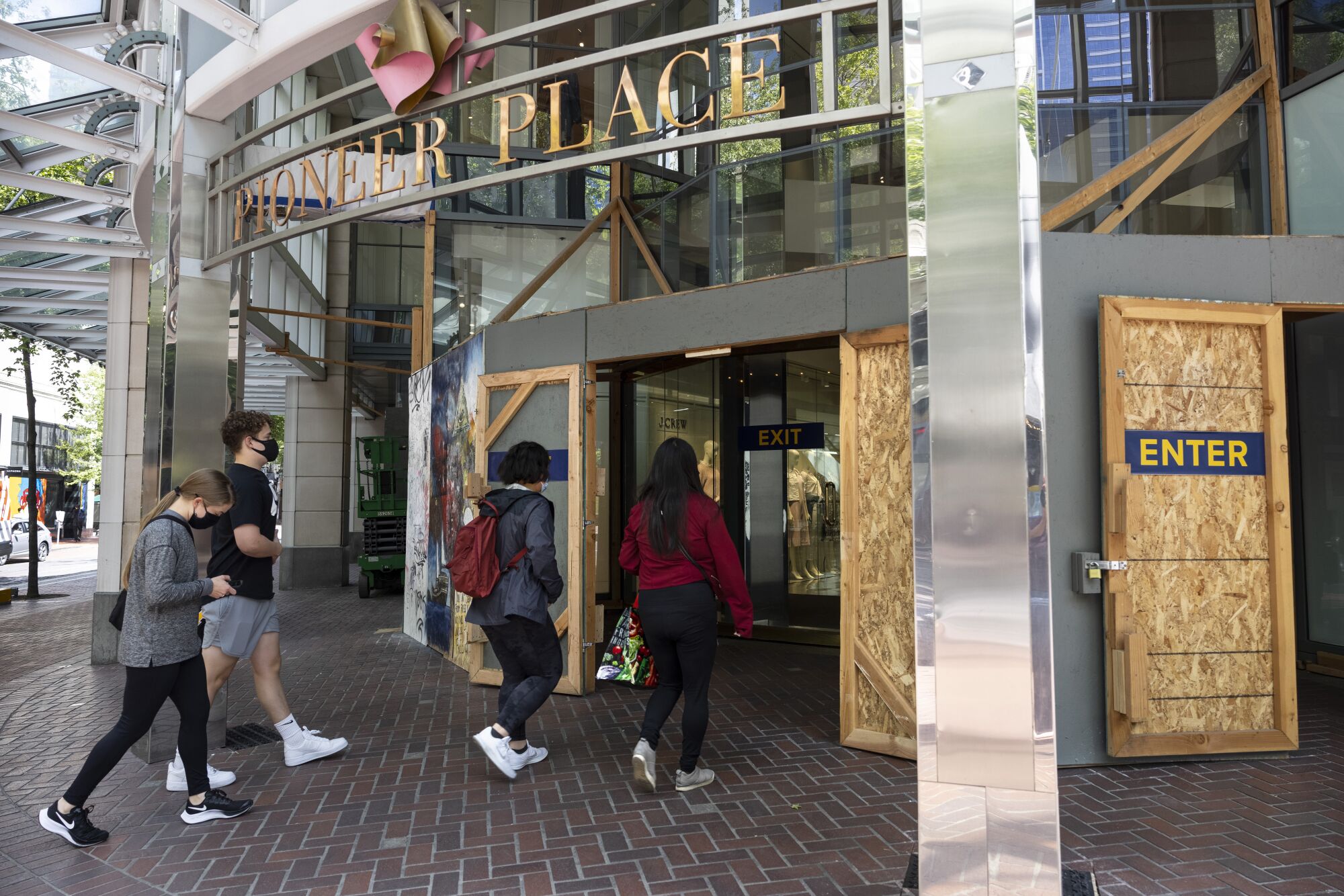
In 2021, Pioneer Place shopping mall stores were boarded up to prevent windows from being smashed by ongoing protests in Portland.
(Paula Bronstein / Associated Press)
Portland is not likely to turn red on any electoral map. But there are signs that the pendulum is swinging to a more moderate kind of politics.
In November, voters approved a historic ballot measure to scrap Portland’s unusual form of government — which had five citywide council members serving as at-large representatives — and replace it with a more typical mayor-council system of 12 commissioners, a mayor and a city administrator.
They also voted out Hardesty in favor of Rene Gonzalez, a moderate Democrat who campaigned on cracking down on crime, getting people off the sidewalks and balancing compassion with the expectation of following the law. Hardesty was defeated in many of Portland’s blue-collar and diverse neighborhoods. But the contest was close, and Portland is still divided between different strains of liberalism and leftism.
The City Council did not immediately approve Wheeler’s new plan to create 20,000 new affordable housing units in the next 10 years. During a heated public meeting after the election, a succession of progressive activists criticized the measure. One resident accused commissioners of “putting money into internment camps.”
“This is further criminalization of our homeless population,” said Daisy Quiñonez, a former planning and sustainability commissioner for the city. “These millions of dollars would be better spent addressing the root causes of homelessness and preventing further homelessness.”
The City Council passed the mayor’s plan on homelessness on Nov. 30.
You don’t have to watch Fox News to look around Portland and say, “This is not cool.”
— Mingus Mapps, city commissioner
Many experts are confident that, in time, the city will rebound.
“Economically, there is nothing fundamentally wrong with Portland,” said Josh Lehner, an economist at the Oregon Office of Economic Analysis. The metro and regional level is stable, Lehner said, and some of the economic activity that is missing downtown will likely pick up in the next few years.
“The question is, ‘Will Portland regain the relatively strong vantage point that it had pre-pandemic?’ ” he said.
Orloff, the historian, said the city’s leaders and residents are fragmented across generations. The tools Portland was celebrated for — the unusual level of citizen engagement and grassroots groups working across neighborhood lines — were faltering.
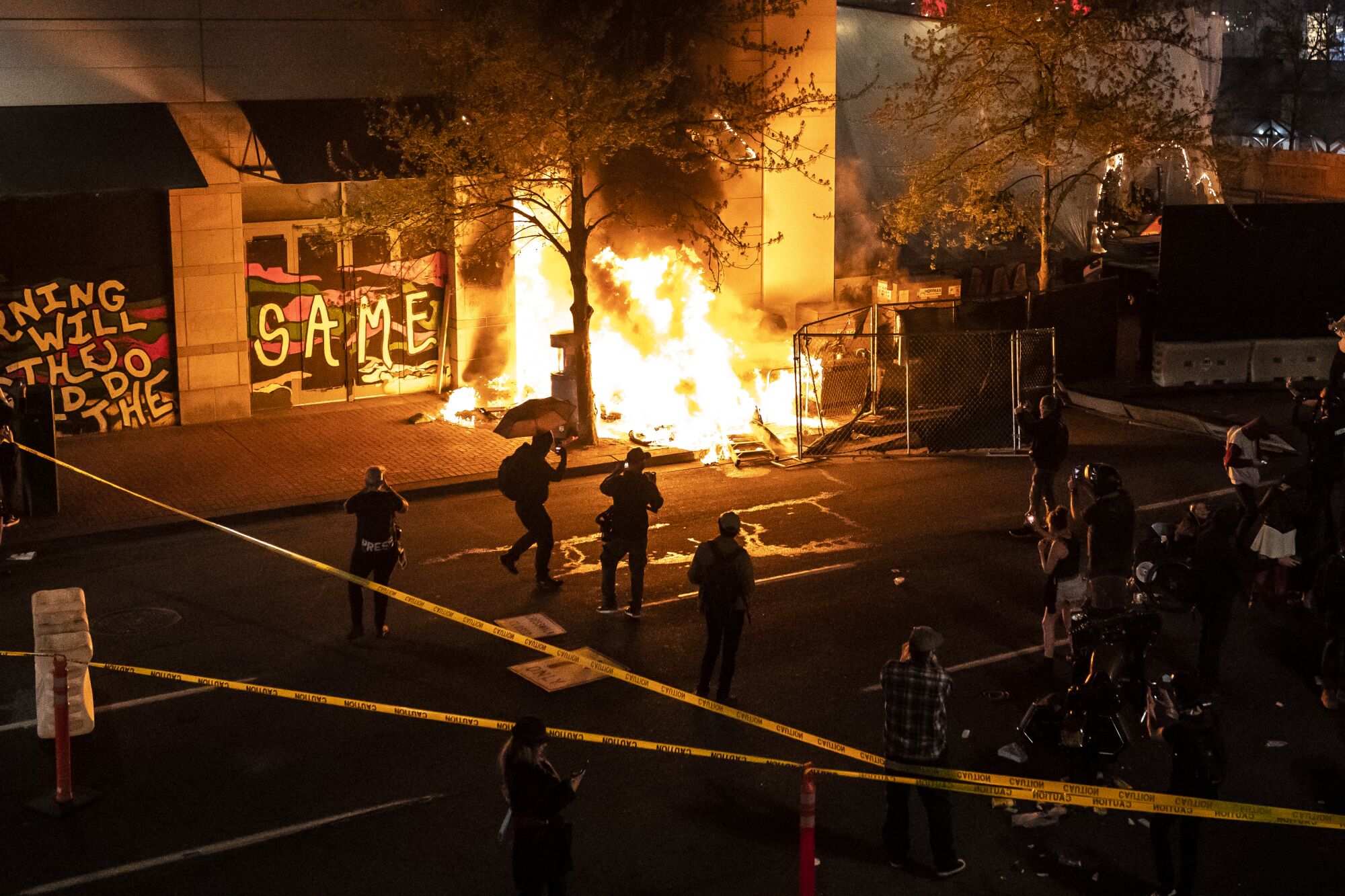
A fire burns on the sidewalk during protests in Portland in April 2021.
(Nathan Howard / Getty Images)
“We’ve lost that sense of a degree of compromise and a degree of patience that was built into good Portlanders,” Orloff said. “Recapturing that is going to take time.”
For City Commissioner Mapps, the status quo is unacceptable. Some recent policies, such as cutting police funds and the state’s decriminalizing hard drugs, he said, have had devastating consequences. But the answer, he argued, was not simply to go back to the old way of doing things as some conservatives suggest.
“Portland has proven abolishing the police doesn’t work,” he said. “Does that mean investing in prevention is a bad idea? No. There have to be carrots and sticks.”
The community has been desperately striving to be its best self and experiment, Mapps said. If it hadn’t always worked, that did not mean liberalism should be thrown out.
But he issued a caveat.
“If we continue to fail,” he said, “liberalism will have been discredited.”
Stay connected with us on social media platform for instant update click here to join our Twitter, & Facebook
We are now on Telegram. Click here to join our channel (@TechiUpdate) and stay updated with the latest Technology headlines.
For all the latest Art-Culture News Click Here
